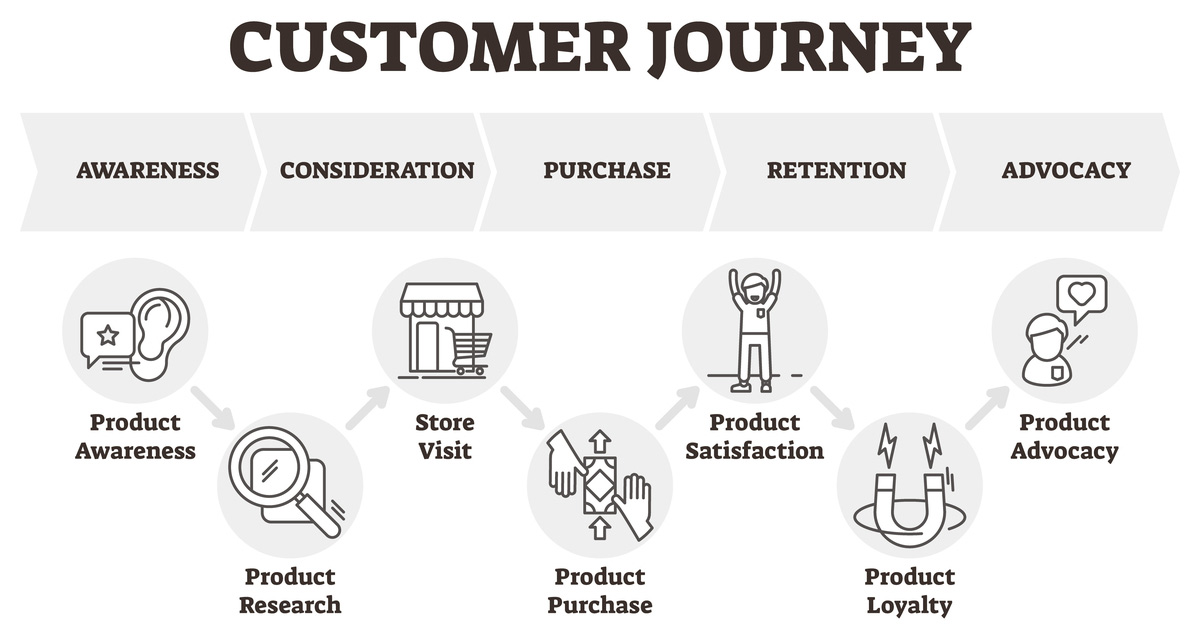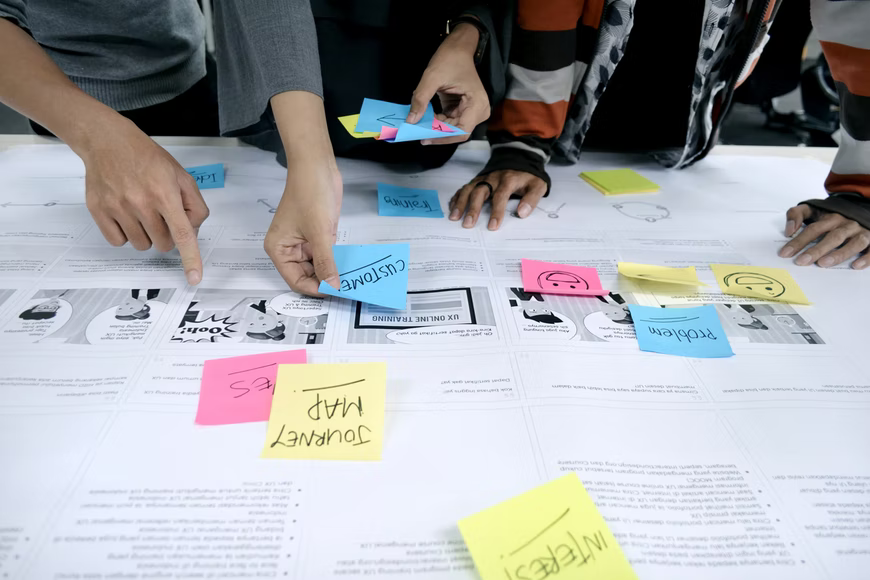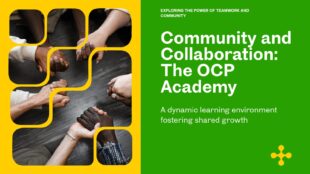
Customer
Journey
One of the never-ending tasks for marketers is to uncover exactly what their audience is doing when they interact with their content, products or services. With this in mind, the customer journey has become a top priority for brands. But what does it mean to have a better customer journey? The customer journey goes beyond simply knowing where your customers are going and being there for them when they arrive.
To create better experiences, companies need to understand how their customers experience the world through multiple points of view and touchpoints. With every interaction from awareness, consideration, and commitment you can learn more about your target audience’s thoughts and desires while producing positive effects such as brand advocacy.
Unbelievable Facts About Customer Journey.

The Customer Journey Mapping Process:-
Awareness
is the first stage of a customer’s journey when they are becoming aware of your product and or brand. The top priority at this stage is to have a high-level understanding of consumer behavior to understand their interests and purchase motivations. At this point, brands need to promote themselves on social media, build a strong blog, and utilize SEO tactics to attract potential customers.
Consideration
is the second stage where consumers begin to evaluate information about your product or service based on their needs and wants. At this stage, consumers are looking for brands that provide detailed information about their product including price ranges, quality, functionality and other essential details which could either make or break a sale.
Purchase
is the third stage of a customer’s journey where consumers have decided to purchase a product or service based on their previous interactions with the brand. At this stage, brands need to remember why their target market wants to purchase from them to provide the right information and presentation before, during and after the purchasing process.
Loyalty & Advocacy
loyalty is the final stage of a customer’s journey where customers develop loyalty for your brand, which results in repeat business and positive word-of-mouth feedback about your products or services. There are two types of advocacy – internal and external – both of which encourage customers to share their opinions online or through offline channels.
Transition
is the last stage of a customer’s journey where customers move from being loyal to becoming brand advocates. At this stage, companies should use their customer file to share what makes them unique and create strategies for meaningful offers that will leave customers feeling enriched.

How to Create a Customer Journey Map?
Step 1- Create a Customer Journey Wheel:
The first step is to create a customer journey wheel that outlines the stages of the buying process. The size of each stage should be proportionate to its influence on the customer’s experience. You can even create an easier to read a version that includes just the highlights.
Step 2- Determine Key Influencers:
Once you’ve created your customer journey, it’s important to determine what factors influence your customers’ path to purchase, how they interact with your brand and what they expect in terms of engagement and brand loyalty. This information will help you create more effective strategies for each stage of the buying process and increase sales through better customer interaction and satisfaction from start to finish.
To achieve this, you need to:
1. Know the customer’s end goal and identify their critical problem.
2. Identify all your offer(s) and determine how they fit in with the needs of the target audience.
3. Define your selling strategy based on what you know about your customers by understanding their needs and solving their problems.
4. Determine who, when and how to engage with your customers at each stage of the journey so that you can meet their expectations along the way.
There are two ways you can use customer journey maps:
1- As a standalone tool.
2- As an assessment tool.
When used as a standalone tool, you can use customer journey maps at every stage of the buying process to build strategies for better engagement and results, including:
- 1- The creation of buyer personas and your marketing content strategies.
- 2- Your social media strategies and social media ads.
- 3- Your email marketing strategies and emails.
- 4- Your website design, cleanliness and organization of information to build trust in your brand.
- 5- Your landing pages and how they specifically target the needs of your audience during each stage of the buying process (awareness, consideration and decision).
If you want to get into the ever-growing world of “Customer Journey”, then OCP Academy is where it’s at. They’ve got an online course that teaches people newbies what they need and helps them learn more about how this industry has become increasingly popular over time!
Related Resource
What’s Holding You Back From the Career You Deserve – Could It Be a Lack of OCP Academy’s Expertise?
Bridging AR and Social Media: How OCP Academy Teaches Creating Interactive Digital Campaigns
Are You One Skill Away from a Promotion – and Is It the One OCP Academy Teaches?
From Learner to Leader: How OCP Academy Shapes the Digital Marketers of Tomorrow
Would You Still Be Doubting Your Potential If You Had the Confidence Built Through OCP Academy?
Recent Posts
- What’s Holding You Back From the Career You Deserve – Could It Be a Lack of OCP Academy’s Expertise?
- Empowering AI Learning: Community and Collaboration at OCP Academy
- Top 7 Reasons to Choose OCP Academy for Your Digital Marketing Certification in 2025
- Bridging AR and Social Media: How OCP Academy Teaches Creating Interactive Digital Campaigns
- Are You One Skill Away from a Promotion – and Is It the One OCP Academy Teaches?
Archives
Categories
- Admission
- Admissions & Enrollment
- AdTech & MarTech EcoSystem
- Aerospace & Defense Technology
- Agency Growth
- AI in Education
- AI in Marketing
- Animation
- AR content creation
- AR filter training
- AR in advertising
- AR Technology
- AR training institute India
- AR, VR, MR, XR
- Artificial Intelligence
- Artificial Intelligence Education
- Asia-Pacific Security
- Audience Engagement
- Augmented reality trends
- B2B Growth
- B2B Marketing
- Brand Building for Engineers
- Brand Digital Presence & Optimization
- Brand Strategy
- Business & Startups
- Business Expansion
- Business Innovation
- Business Intelligence
- Career & Placement
- Career Advice
- Career Change & Upskilling
- Career Developmen
- Career Development
- Career Growth
- Career Guidance
- Career In Digital Marketing
- Career Skills Development
- Career Transformation
- Case Studies
- Certification Programs
- Certifications
- Chandrayaan
- ChatGPT
- Client Acquisition & Retention
- Client Management
- Client Relationship Management
- Collaborative Learning
- Construction Business
- Consumer Awareness
- Content Marketing
- Content Marketing Insights
- Content Strategy
- Corporate Social Responsibility (CSR)
- Cross-Cultural Communication
- Current Affairs
- Customer Engagement
- Customer Experience
- Customer Journey
- Customer Relationship Management (CRM)
- Cyber Threat Intelligence
- Cybersecurity
- Data Analytics
- Data Science
- Data Science in Marketing
- Data-Driven Marketing
- Database Technologies
- Defense
- Digital Career Readiness
- Digital Careers & Opportunities
- Digital Marketing
- Digital Marketing Courses
- Digital Marketing Education
- Digital Marketing Foundation
- Digital Marketing Freelancing Business
- Digital Marketing Skills
- Digital Marketing Strategies
- Digital marmeting
- Digital Skills Development
- Digital Skills Training
- Digital Transformation
- Digital Trust
- Display Marketing
- Doctor
- E-commerce
- E-Commerce & Online Services
- E-Commerce Management
- E-commerce Marketing
- E-Learning
- E-learning Accreditation
- E-Learning Opportunities
- E-learning Platforms
- Eco-Friendly Business Practices
- Editorial & Opinion
- EdTech
- EdTech Industry Insights
- EdTech Reviews
- EdTech Training Programs
- EdTech Trends
- Education
- Education & Learning
- Education Marketing
- Education Sector Insights
- Education Technology
- Education Technology (EdTech)
- Education,
- Educational Institutions
- Effective Email Marketing
- Email Marketing
- Email Marketing Techniques
- Emerging Technologies for Digital Marketing
- Engineering Business
- Engineering Innovations
- Entertainment
- Entertainment Branding
- Entertainment Marketing
- Entrepreneurship
- Entrepreneurship & Digital Growth
- Environment & Climate
- Farming & Agriculture
- Film Industry
- Film Industry Insights
- Film Marketing
- Freelancer Marketing Tips
- Freelancing
- Fundamentals of Social Media
- Future of Business
- Future of Digital Marketing
- Future Trends
- Gambling
- Geopolitics
- Global Marketing
- Green Technology
- Growth Hacking for Apps
- Growth Marketing
- Healthcare Marketing
- Human Rights & Conflict
- iGaming
- Immersive Technologies
- Impact of COVID-19
- Inbound Marketing
- India
- India-Pakistan Relations
- India’s Armed Forces
- Indian
- Indian Defense
- Indigenous Defense Development
- Industry Case Studies
- Industry Insights
- Industry-Relevant Training
- Influencer Marketing
- Information Security News
- Information Technology
- Infrastructure
- Intelligence and Espionage
- Interactive user experience
- International Business
- International Defense Cooperation
- Internship
- IT Industry Insights
- IT Jobs & Careers
- Jammu & Kashmir
- JOB
- Job-Oriented Courses
- Jobs
- Kashmir Conflict
- kasyno online automaty
- Lead Generation
- Lifelong Learning
- local business
- Local Business Growth
- local SEO
- Local SEO for Schools
- Local SEO Strategies
- Manufacturing
- Marketing Automation
- Marketing Certifications
- Marketing Courses in India
- Marketing Education
- Marketing for Institutions
- Marketing Leadership Programs
- Marketing Metrics & KPIs
- Marketing Strategies
- Marketing Strategy
- Marketing Technology
- Marketing Technology (MarTech)
- Marketing Tools
- Marketing Trends
- Marketing Trends 2025
- Media & Broadcasting
- Media & Entertainment
- Mentorship
- Mentorship in Tech
- Mentorship Programs
- Meta Spark AR learning
- Military Operations
- Military Strategy
- Military Technology
- Missile Technology
- Mobile App Marketing
- Mobile Apps & Innovation
- Mobile Commerce
- Mobile Tools
- Movie Promotions
- National News
- National Security
- new
- News Industry Trends
- OCP Academy
- OCP Academy courses
- OCP Academy Insights
- Off-Site SEO
- On-Site SEO
- Online Advertising
- Online Branding
- Online Courses
- Online Digital Marketing Certificate Programs
- Online Journalism
- Online Learning
- Online Learning Platforms
- Online Learning Programs
- online marketing
- Online Reputation Management
- Online Safety & Scams
- Parent Engagement
- Parenting & Technology
- Performance Marketing
- Personal Development
- Politics & Policy
- Post Graduate Digital Marketing Course
- PPC Ads
- Professional Certification
- Professional Development
- Professional Growth
- Professional Training & Certification
- Professional Training Programs
- Ratan Tata
- Real-time user engagement
- Real-World Applications
- Realstate
- Reel
- Remote Client Management
- Sales
- School Growth Strategies
- Search Engine Marketing
- Search Engine Optimization
- SEO
- SEO & Search Marketing
- SEO & Search Strategy
- SEO for Engineers
- shopkeeper
- Shorts
- Skill Development
- Skill Enhancement
- Skill-Based Learning
- Skills Development
- Small Business
- Small business growth
- Small Business Tips
- Snapchat Lens Studio tutorials
- Social Media
- Social Media Engagement
- Social media innovation
- Social Media Marketing
- Social Media Strategy
- South Asia
- South Asian Security
- Space Science
- Startup Hub
- Startup India
- Startup Marketing
- Stock Market
- Student Resources
- Student Success Stories
- Sustainability
- Tech-Driven Careers
- Technology
- Technology in Media
- Technology Trends
- Terrorism & Security
- The Path to Digital Journey
- Tourism & Economy
- Trending Technologies 2025
- Uncategorized
- Urban Mobility
- User Experience (UX)
- Video Marketing
- Visual storytelling with AR
- Web Analytics & Metrics
- Web Design
- Workshop Highlights & Webinars
- XR in marketing
- YouTube












